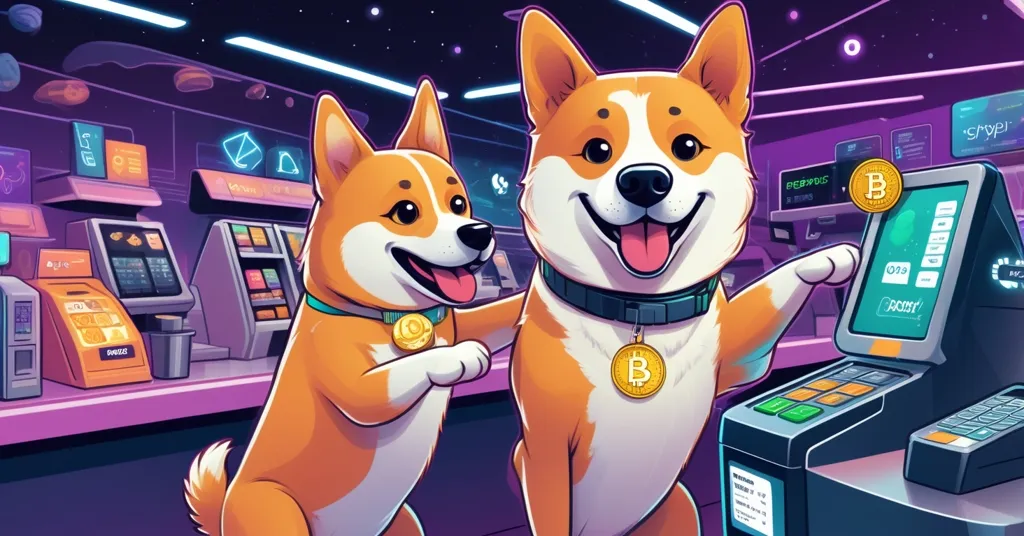Dogecoin Stuck at $0.35 as SpacePay Pushes Real-World Crypto Payments

Dogecoin Stalls at $0.35 as SpacePay Targets Real-World Crypto Adoption
Dogecoin (DOGE), the internet’s favorite meme coin, continues to flounder below the stubborn $0.35 price barrier, a clear sign of its struggle to find real economic footing beyond viral tweets and speculative frenzy. While DOGE holders wait for the next pump, a new platform called SpacePay is stepping up with a bold plan to inject practical utility into cryptocurrencies like DOGE by enabling seamless merchant transactions. Let’s unpack this mess and see if utility can save meme coins from their own hype.
- Dogecoin remains stuck below $0.35 due to a glaring lack of real-world use cases.
- SpacePay aims to bridge this gap with a payment platform for DOGE and over 325 other cryptos.
- Sustainable crypto growth hinges on commerce-driven demand, not speculative gambling.
Dogecoin’s $0.35 Dilemma: Hype Isn’t Enough
Dogecoin burst onto the scene as a joke in 2013, only to become a cultural phenomenon by 2021, propelled by endorsements from figures like Elon Musk and a fiercely loyal online community. Yet, despite its past highs, DOGE keeps hitting a wall at $0.35—a price resistance level where selling pressure consistently smothers any upward momentum. For the uninitiated, price resistance is a threshold where buyers just can’t muster enough strength to push the value higher, often due to psychological barriers or, in DOGE’s case, fundamental weaknesses. And let’s be brutally honest: Dogecoin price analysis reveals a harsh truth—without places to actually spend it, DOGE’s worth is tied to fleeting sentiment, not solid economics.
The core issue is utility, or rather, the absence of it. In crypto terms, utility means having practical applications—think buying a burger or paying for a subscription—not just sitting in a wallet as a speculative bet. Bitcoin, despite its own volatility, has carved out a niche as a store of value and, in some regions, a medium of exchange. DOGE? It’s mostly a punchline with a market cap, cherished by its community but rarely accepted by merchants. Most holders are stuck HODLing, praying for another viral moment, while so-called “technical analysis” and chart predictions flood social media with baseless nonsense. We’re not buying that shilling garbage here—most of it is just wild guesses dressed up as expertise. Without real demand from everyday use, DOGE’s $0.35 ceiling isn’t budging anytime soon.
But there’s more to DOGE than just memes. Its community strength is undeniable, with past initiatives like charity drives and even Tesla briefly accepting it for merchandise showing flickers of potential. If that cultural energy could be channeled into tangible spending power, DOGE might stand a chance. The question is, can a meme coin find purpose beyond Twitter mania, or is it doomed to be a nostalgic relic of crypto’s wild west days?
SpacePay’s Vision: Blockchain Payment Solutions for Real Transactions
Enter SpacePay, a platform that claims to tackle the utility void head-on, not just for DOGE but for a sprawling list of over 325 cryptocurrencies. Their mission isn’t about promising moonshot returns or peddling the latest NFT fad—it’s about making crypto spendable in the real world through seamless merchant integration. The concept is deceptively simple: enable businesses to accept DOGE and other digital coins via existing point-of-sale (POS) systems, which are the checkout terminals you see at stores, often running on Android software similar to many smartphones. For merchants, this means no need to overhaul their setup or become blockchain experts—just plug and play to start accepting crypto payments.
SpacePay’s hook is a razor-thin transaction fee of 0.5%. To put that in perspective, it’s a small cost per sale—kind of like a tiny tip to the system processing the payment—compared to the 2-3% or more charged by traditional giants like Visa or PayPal. Lower fees could be a game-changer for businesses looking to maximize profit margins, while for crypto holders, it reduces the sting of spending their tokens. Add to that compatibility with over 325 wallet providers—think MetaMask, Trust Wallet, and countless others—and SpacePay seems poised to make crypto transactions accessible to a wide swath of users. They’ve also prioritized playing by the rules, ensuring regulatory compliance across all unsanctioned nations to dodge the legal hammer that’s crushed less cautious projects. For more on their approach to real-world adoption, check out this detailed overview on Dogecoin’s challenges and SpacePay’s solutions.
Their focus on practical application over empty promises has earned some recognition. SpacePay snagged the title of “New Payment Platform of the Year” at the CorporateLiveWire Global Awards 2022/23, lending a bit of credibility in an industry often drowning in hot air. Their SPY token presale has also raised over $1.3 million, with tokens priced at $0.003181 during the ongoing sale. Unlike the typical “buy low, hope for a spike” altcoin gamble, SPY holders are pitched a share of the platform’s growth through revenue tied to transaction volume. Think of it like getting a cut of a shop’s sales for helping drive customers through the door—a model rooted in actual usage rather than blind betting.
Merchant Adoption: The Holy Grail of Crypto Growth
Let’s cut through the noise—merchant adoption isn’t just a trendy buzzword; it’s the linchpin for crypto’s mainstream future. When businesses accept digital currencies as easily as they do credit cards, you create a virtuous cycle: more users spend their tokens, more merchants join the fray, and demand grows from real purchases, not Reddit-fueled pumps. Historically, though, this has been a slog. Price volatility scares merchants—imagine accepting DOGE at $0.35 only for it to crash to $0.20 overnight. Technical barriers and lack of consumer interest haven’t helped either. Even Bitcoin, with over a decade of effort, has limited merchant traction outside niche hubs like El Salvador, as data from platforms like CoinMap shows sparse global acceptance.
SpacePay isn’t the first to try bridging this gap—competitors like BitPay and Coinbase Commerce have been at it for years. But with a 0.5% fee and broad wallet support, SpacePay might have an edge, assuming they can deliver. Still, let’s not pop the champagne yet. Scaling globally, convincing risk-averse merchants, and navigating tightening regulations are brutal challenges. And there’s a deeper concern: if SpacePay becomes a dominant middleman, does it risk centralizing what should be a decentralized revolution? For all its potential, this isn’t a flawless savior for crypto’s utility woes—it’s a promising experiment with plenty of hurdles.
Bitcoin’s Shadow: Maximalism Meets Ecosystem Diversity
As Bitcoin maximalists, we can’t help but view this through the lens of the original crypto king. Many in the BTC camp would argue that meme coins like DOGE are sideshows at best, distractions from Bitcoin’s mission as sound money. And they’ve got a point—countless altcoins have flamed out over the years, from 2017’s ICO busts to endless rug pulls. Yet, decentralization thrives on diversity. Ethereum’s smart contracts birthed DeFi and dApps, filling gaps Bitcoin doesn’t address. DOGE’s cultural pull, while often frivolous, keeps people engaged in ways BTC’s austere narrative can’t match.
Could SpacePay’s model benefit Bitcoin too? The Lightning Network is already tackling payment scalability for BTC, enabling near-instant, low-cost transactions in places like El Salvador. But platforms like SpacePay could complement those efforts by onboarding merchants who might shy away from Bitcoin’s perceived complexity or volatility. Or, perhaps, maximalists would scoff, insisting BTC’s store-of-value status renders such payment systems irrelevant. Either way, the push for crypto real-world use cases aligns with our belief in disrupting outdated financial systems—one transaction at a time.
What’s Next for DOGE and Decentralized Payment Platforms?
Looking ahead, Dogecoin’s short-term fate likely hinges on whether platforms like SpacePay can spark genuine spending demand or if another wave of social media buzz temporarily lifts it past $0.35. For SpacePay, the test will be execution—can they onboard enough merchants to create a network effect, or will they stumble under the weight of logistics and skepticism? Broader implications loom large: if utility drives crypto’s future, are meme coins doomed without a lifeline, or can cultural relevance alone keep them afloat?
Ultimately, the shift from speculation to commerce is the no-bullshit direction crypto needs. We’re not here to peddle get-rich-quick fantasies but to champion systems that challenge the status quo. If that means spending DOGE on a sandwich instead of kneeling at the altar of a Twitter pump, count us in. The decentralized revolution isn’t about memes or moonshots—it’s about building a financial future that works.
Key Takeaways and Questions
- Why is Dogecoin stuck below $0.35?
Its lack of real-world utility means demand is mostly speculative, with few places to spend it driving consistent value growth. - How does SpacePay aim to solve DOGE’s utility gap?
By integrating DOGE payments into merchant POS systems with a low 0.5% fee and support for over 325 wallets, creating actual transaction opportunities. - Why is merchant adoption critical for cryptocurrency growth?
It shifts crypto from a speculative asset to functional money, building demand through everyday purchases rather than volatile trading. - Does SpacePay stand out from other crypto projects?
Their emphasis on transaction revenue, regulatory compliance, and merchant integration offers a practical edge over hype-driven schemes, though risks remain. - What could DOGE holders gain from platforms like SpacePay?
The ability to use DOGE for real purchases and, through SPY tokens, potentially profit from transaction volume growth rather than price bets.



